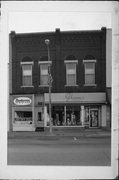| Additional Information: | The present building was constructed in 1895 with two occupants. At 107 South Water Street (north store), there was Frank A. Young's boot and shoe store and at 109 South Water Street (south store), there was Simpson and Schmidt's hardware store with a tin shop in the rear.
In 1904, C.E. Simpson's Hardware Store was still at 109 South Water Street with a tin shop in the rear, however, at 107 South Water Street, there now was John D. Reese's tailor shop. These two businesses occupied these same addresses in 1916.
The W.C. Hoffman Building gains local significance under Criteria A as an example of the general merchandise businesses common in the late nineteenth and early twentieth centuries. As indicated within the Commercial Theme, these enterprises (hardware stores, boot and shoe stores, etc.) played a central role in the growth and stability of the community's business. The period of historical significance extends from 1895 to perhaps as late as 1916.
This Romanesque revival influenced two-story, four-bay commercial building has a red brick facade divided vertically into two wide bays by full-length pilasters that are ornamented by caps of decorative brick work. The facade is ornamented by a wide band of decorative brick work that includes a corbeled brick cornice. Decorative brick work also ornaments the tympanum of the blind round arches above the stone lintels of the four long narrow windows, two in each bay. A contemporary storefrton with recessed off-set metal and glass entrance and windows is located on the south commercial space. A storefront with a wooden apron and a recessed off-set entrance with a wood and glass door that is flanked by iron columns characterizes the north storefront.
This brick commercial block has been altered by the addition of metal replacement windows to the upper story and by the addition of a contemporary storefront to the south end of the lower story.
This Romanesque Revival building was constructed in 1895 by local masonry contractor L.V. Huschka. Designed by local architect Frank D. Foote, this building was constructed as investment property for W.C. Hoffman. Replacing an earlier frame building on the site occupied by tinsmith Charles Bruilette, this building originally was used for a hardware store by Bruilette who moved back into the new building, and by the Frank Young Shore Store. Part of the second story of the new building was used by the Herald Advertiser. This building, constructed on a foundation of concrete and rubble limestone from quarries opened north of town, was described when under construction as showing "a handsome front contrasting quite radically" with the adjacent WTCU building under construction at the same time and designed by the same architect.
The W.C. Hoffman Building is significant under Criterion C as an example of the Romanesque Revival influence. Displaying minimal Romanesque Revival features [mainly round arched blind arches above the windows], this building is one of two well preserved examples of the Romanesque style in the district. The Hoffman Building and the Monroe County Courthouse are the best examples of the Romanesque Revival style in the Water Street Historic District. |
|---|
| Bibliographic References: | (A) City of Sparta, WI, Tax Records, 1870-1930.
(B) Sparta Herald Feb. 5, 1895; March 19, 1895; April 15, 1895; April 30, 1895; June 4, 1895; July 9, 1895.
(C) Sanborn Insurance Map 1884, 1889, 1894, 1900, 1911, 1922, 1931.
(D) City of Sparta Property Tax Rolls, 1870-1940.
(E) Annual Directory of Sparta, Wisconsin. Vol. 1. Chicago: Interstate Directory, Co., 1897.
(F) Sparta City Directory, 1903-1904. Sparta: R.C. Glover, Publisher, 1904.
(G) City DIrectory of the City of Sparta, Wisconsin. Sparta: compiled and published by E.B. Bell, 1916. |
|---|

